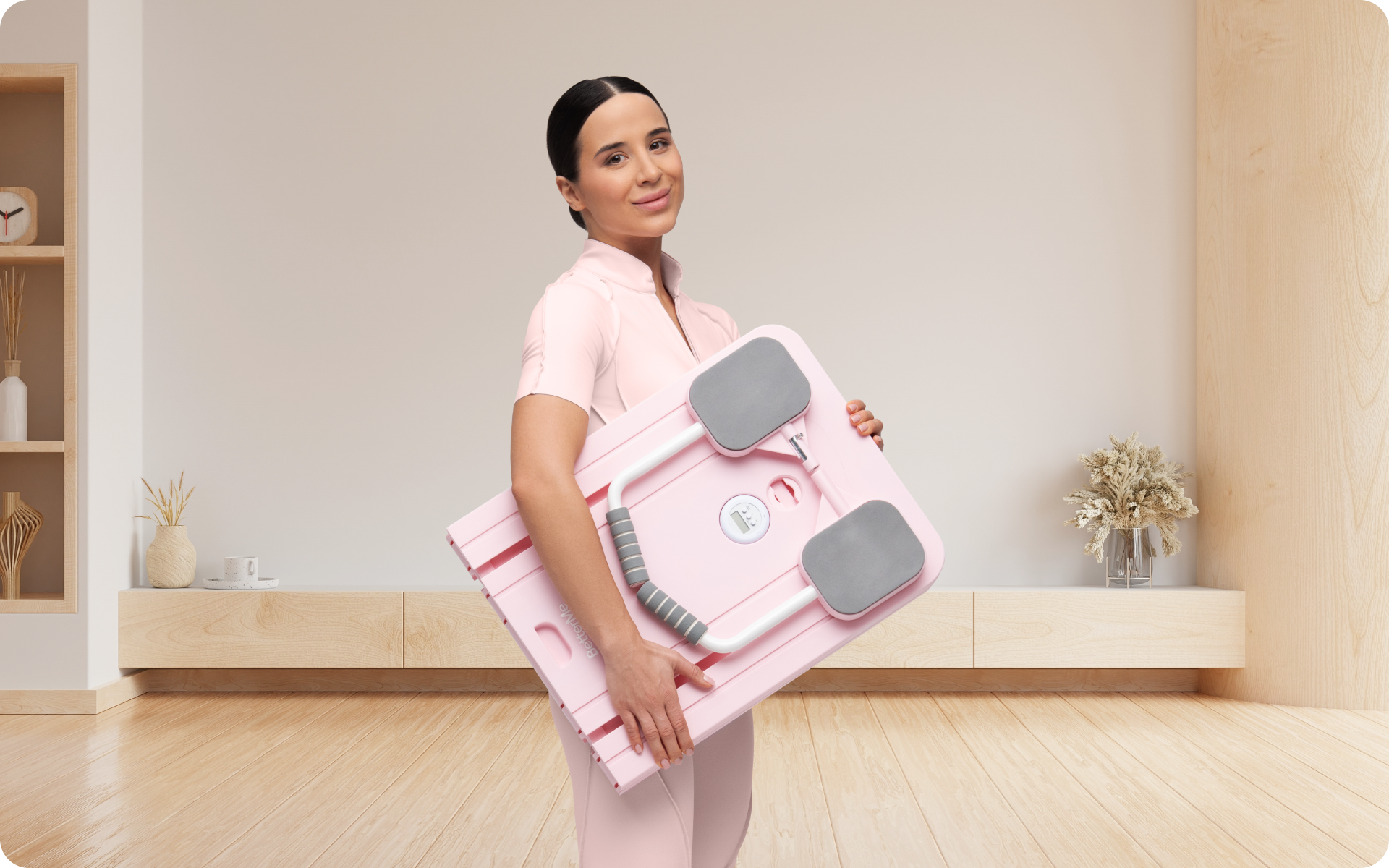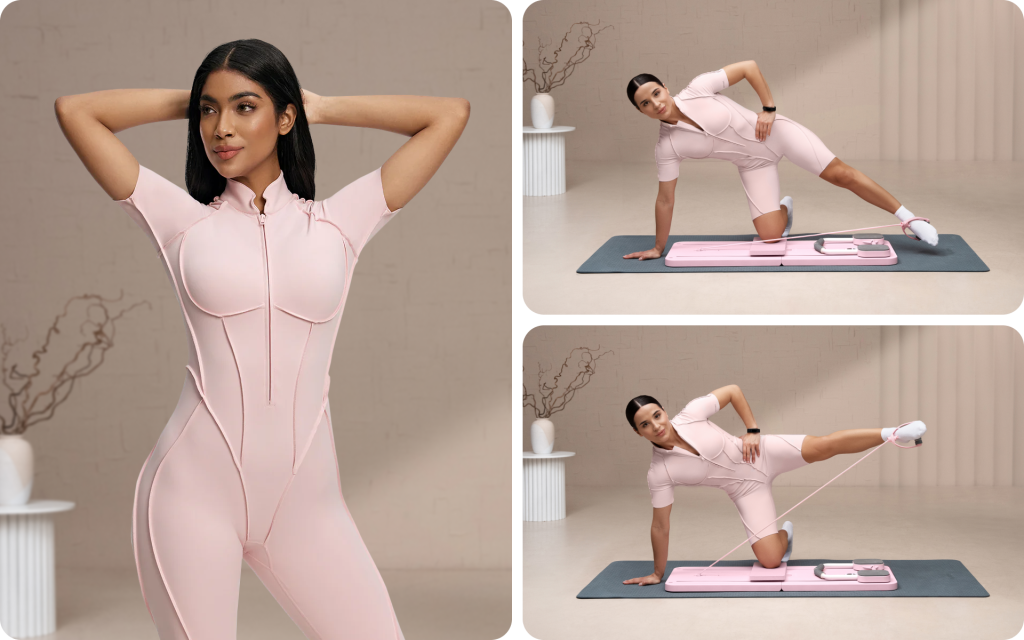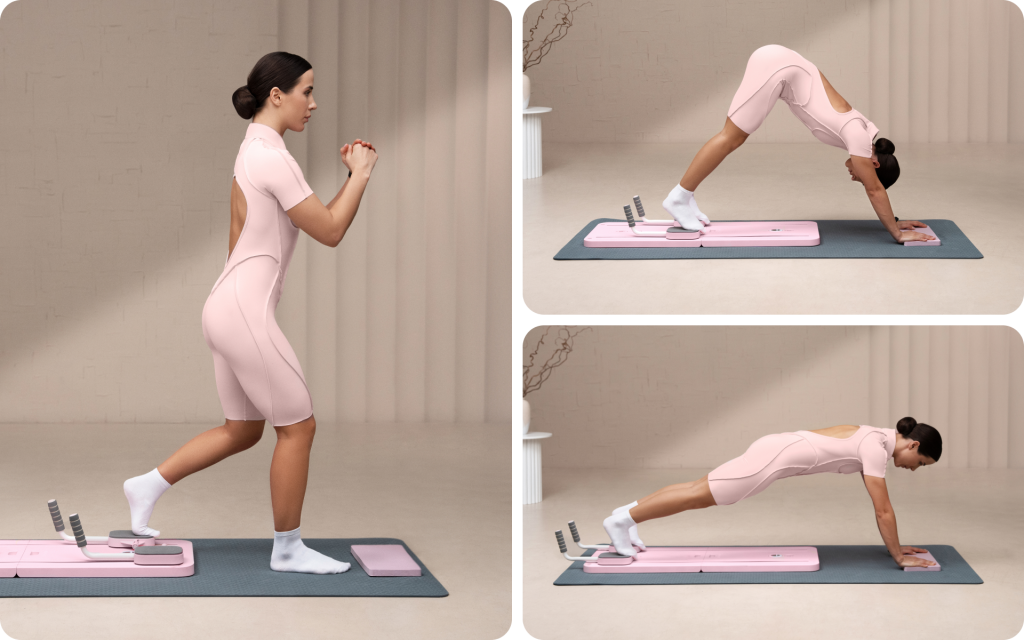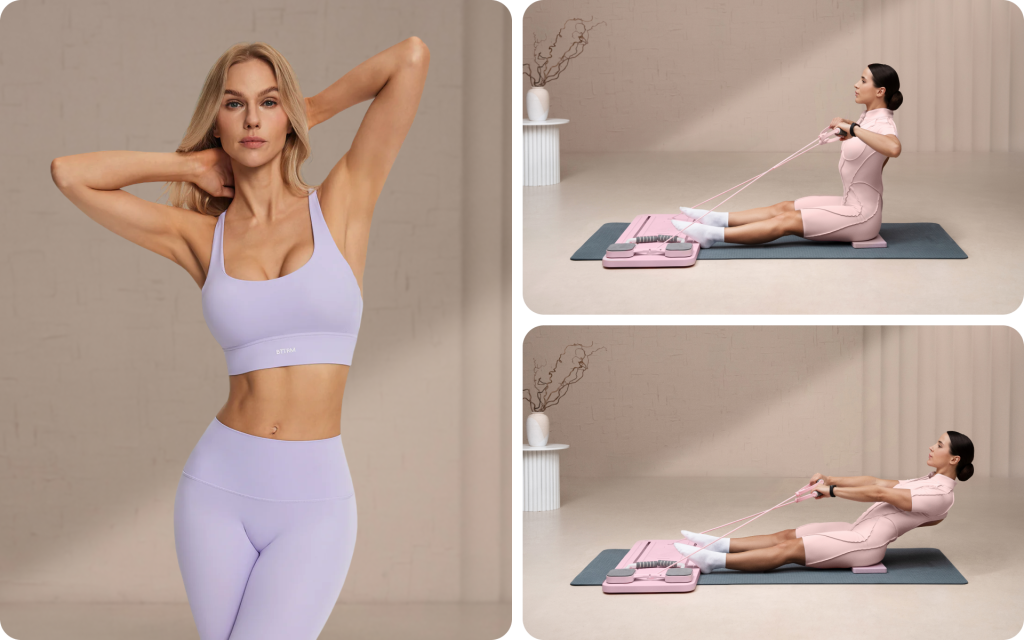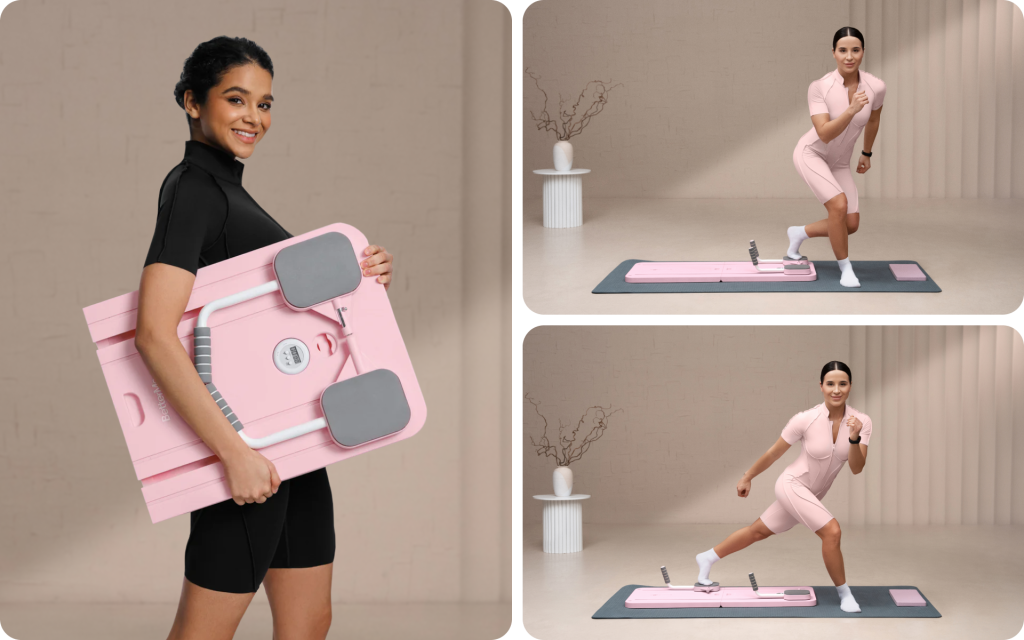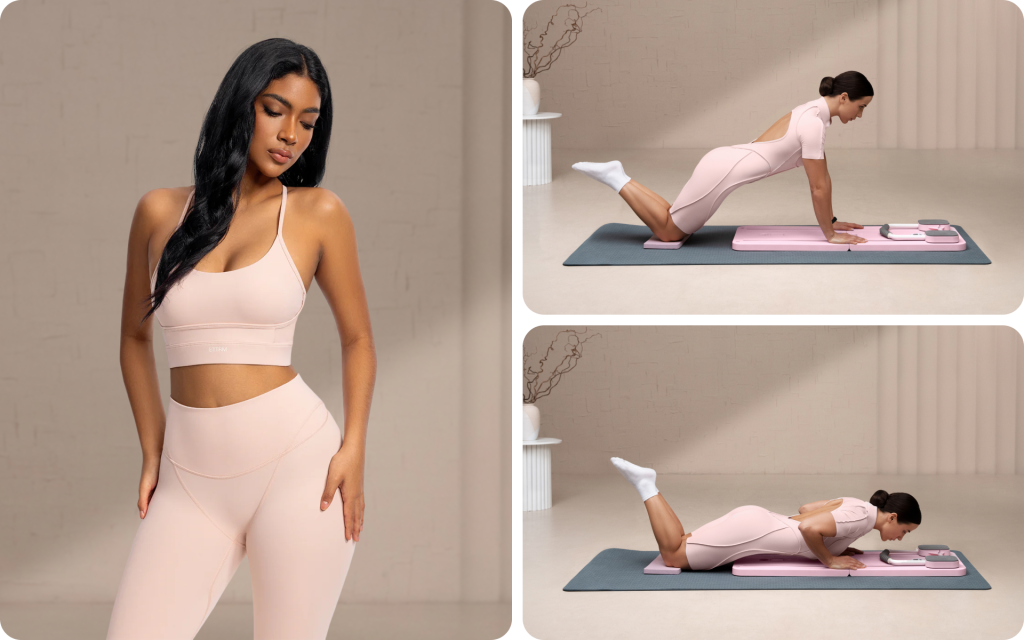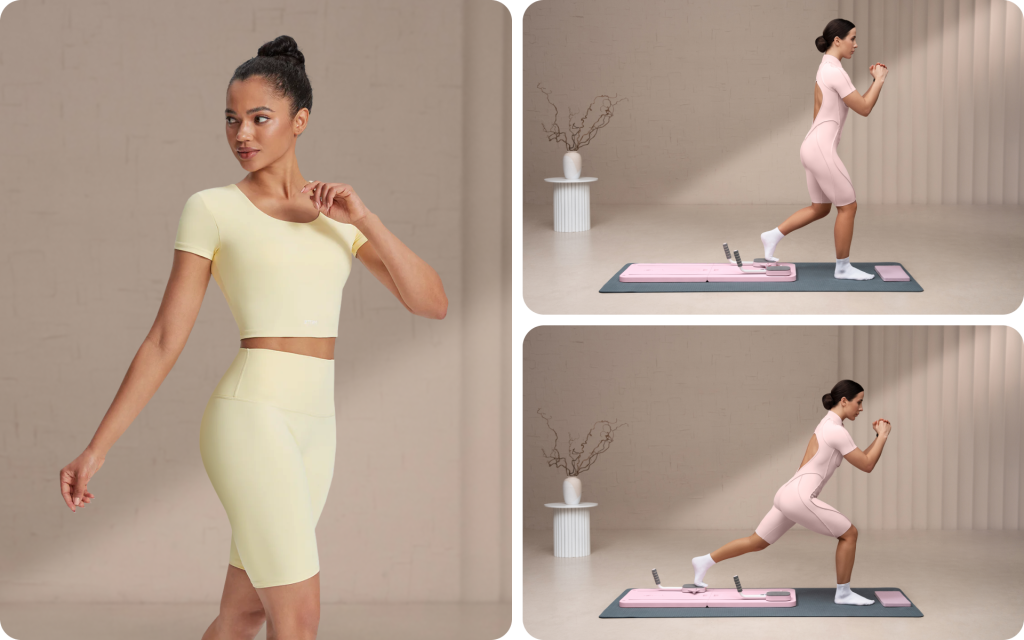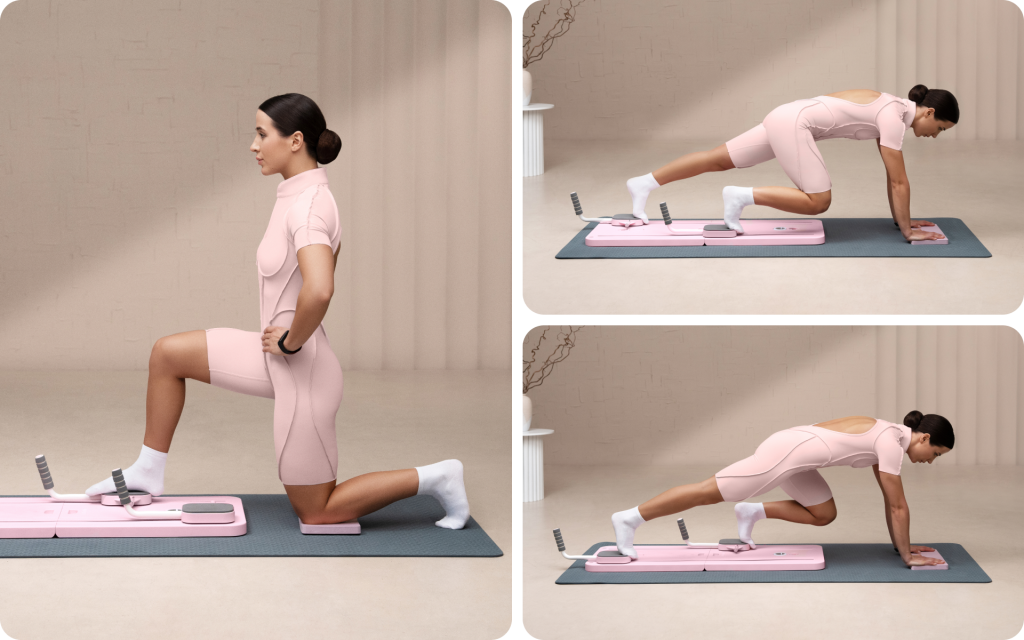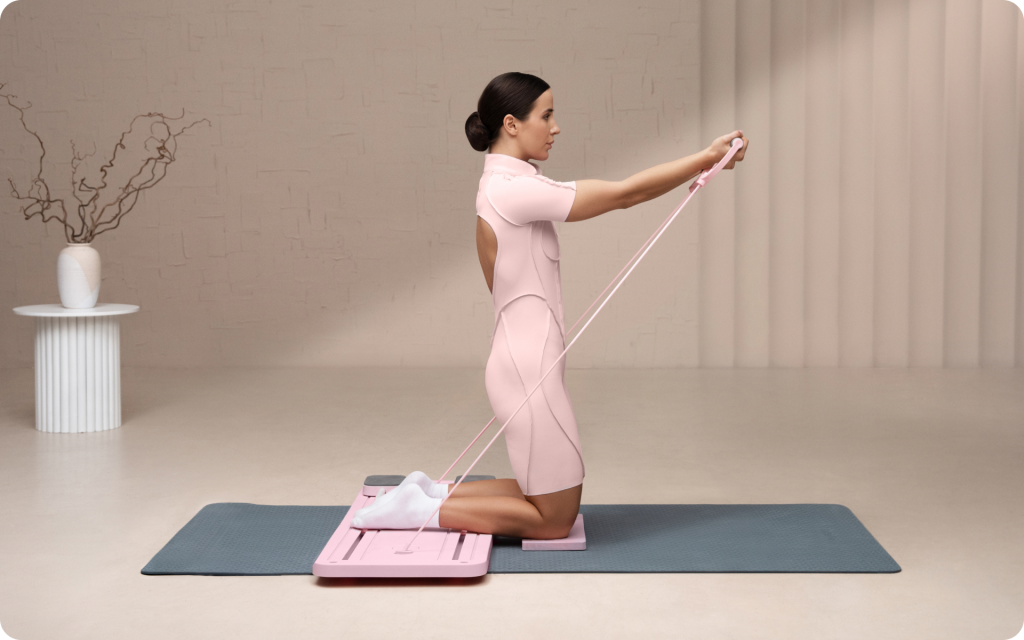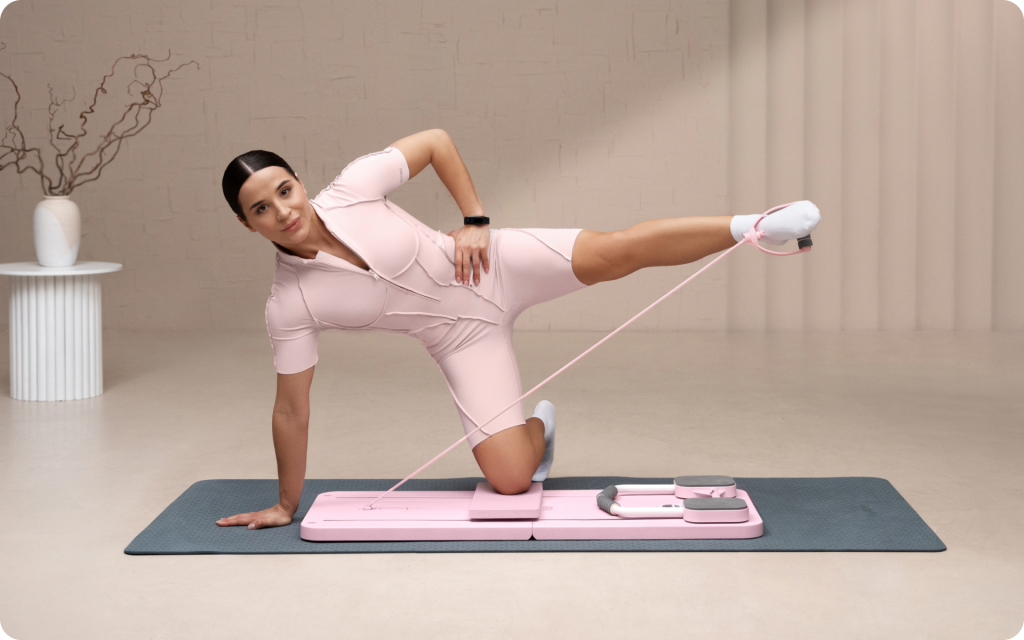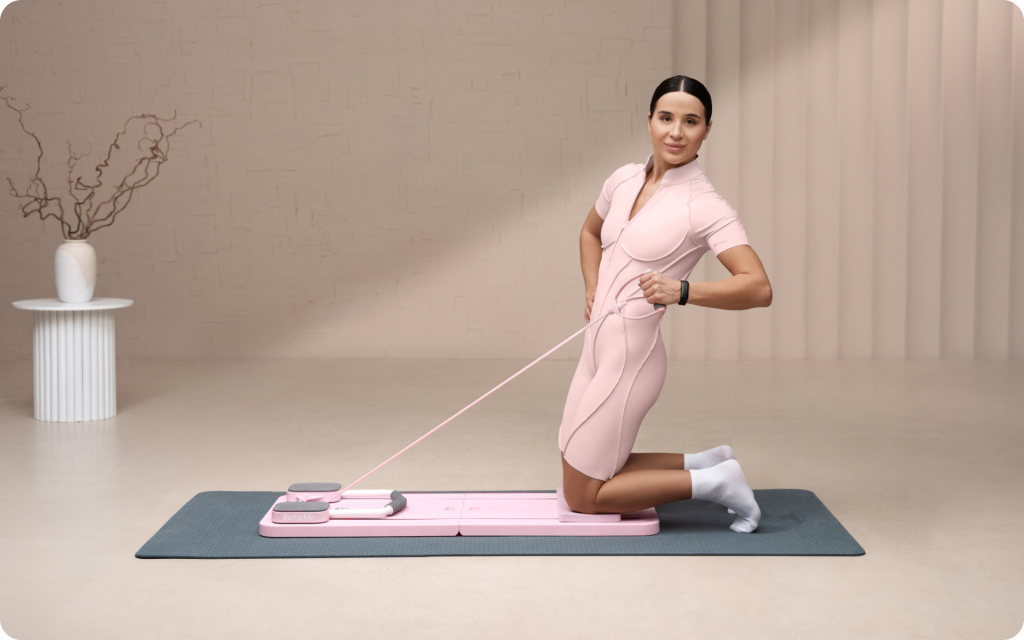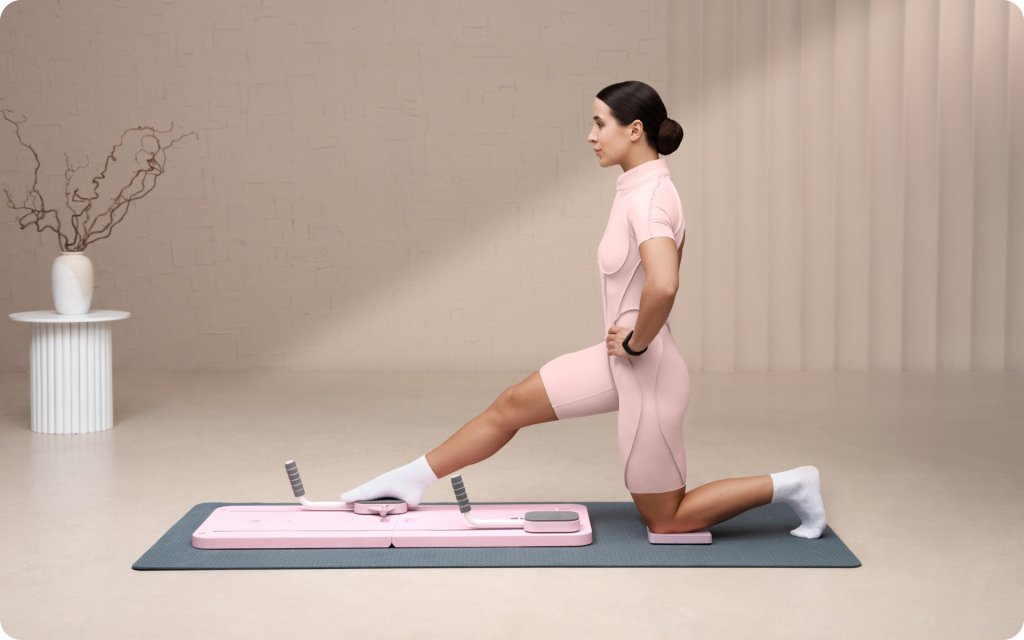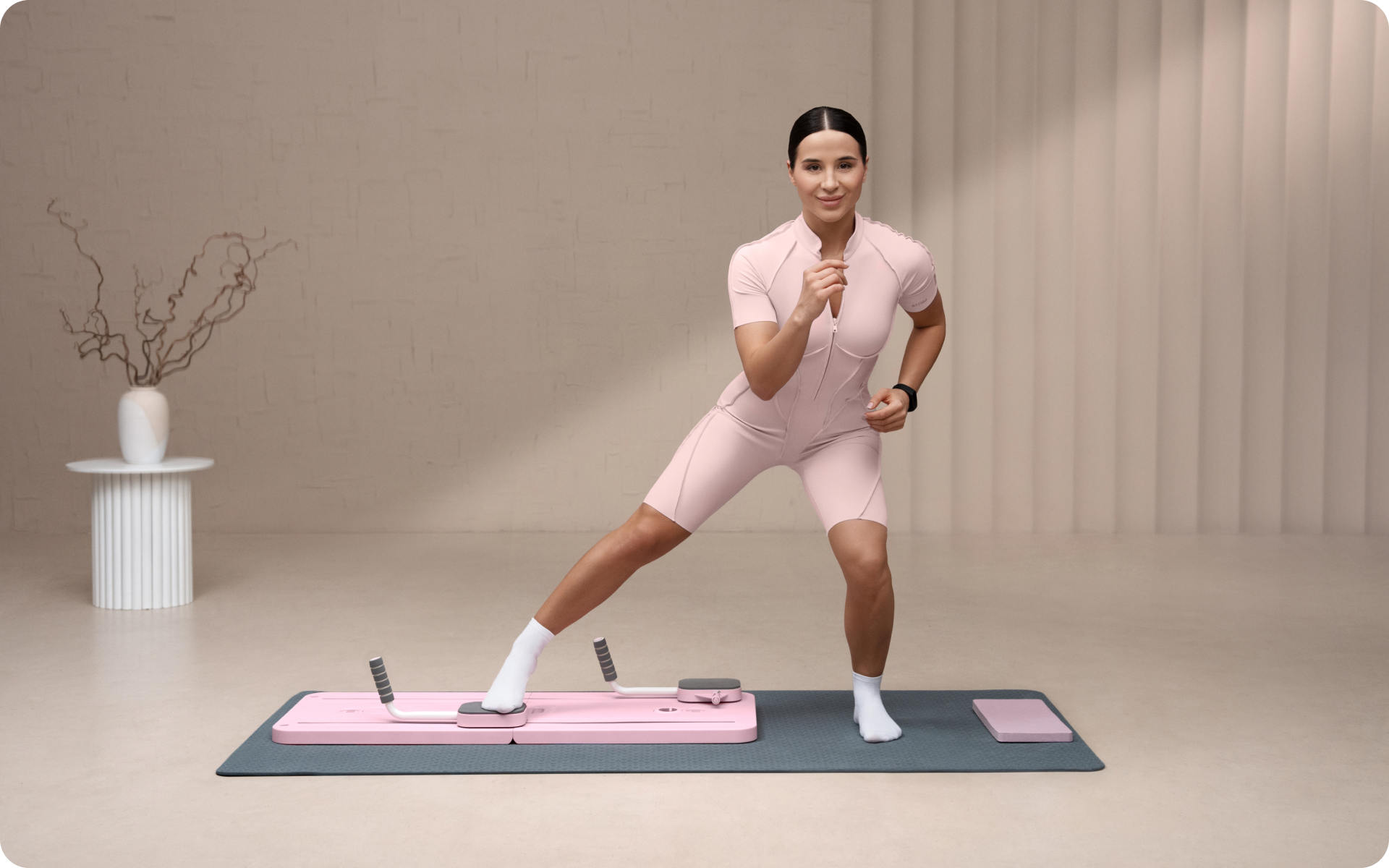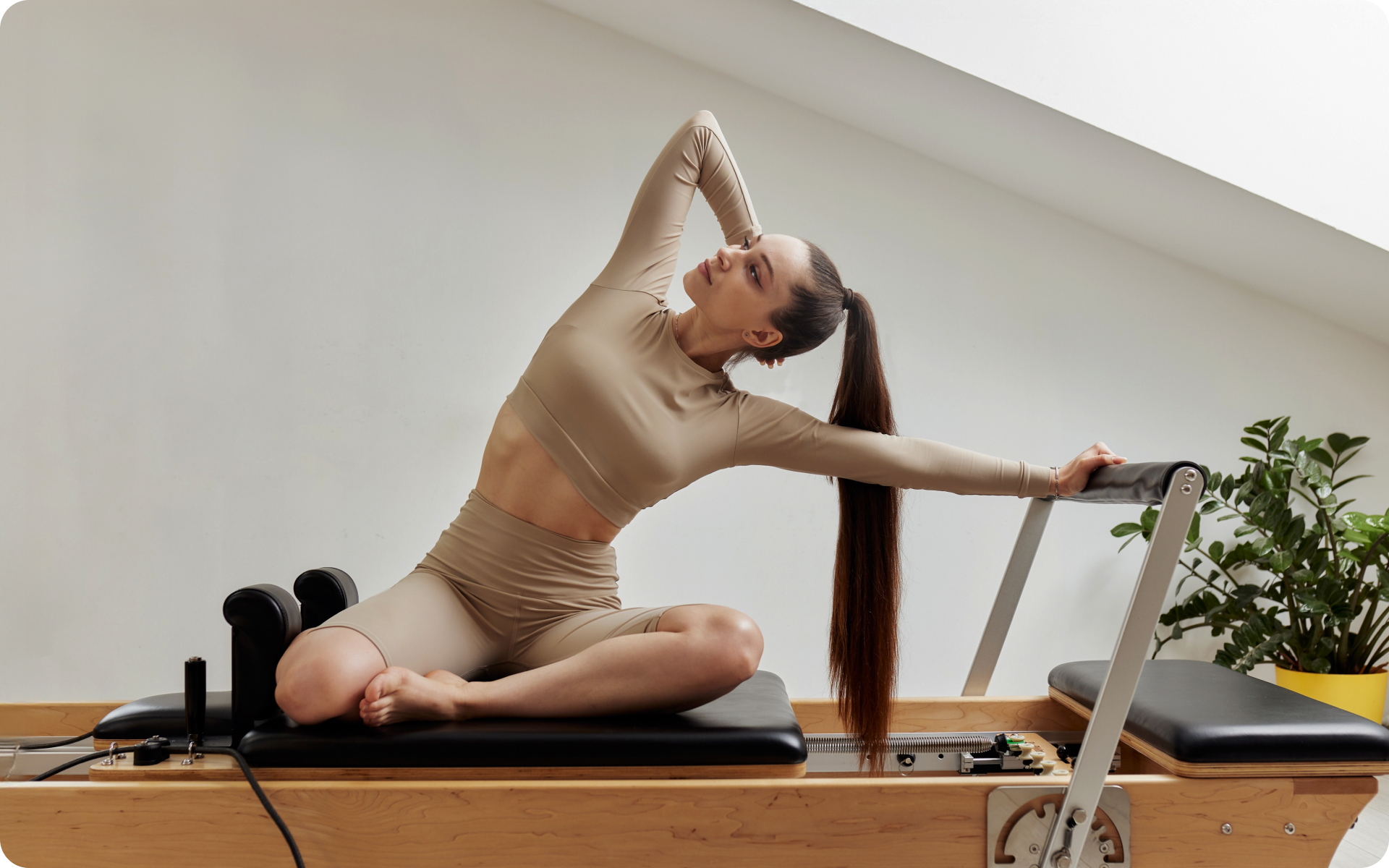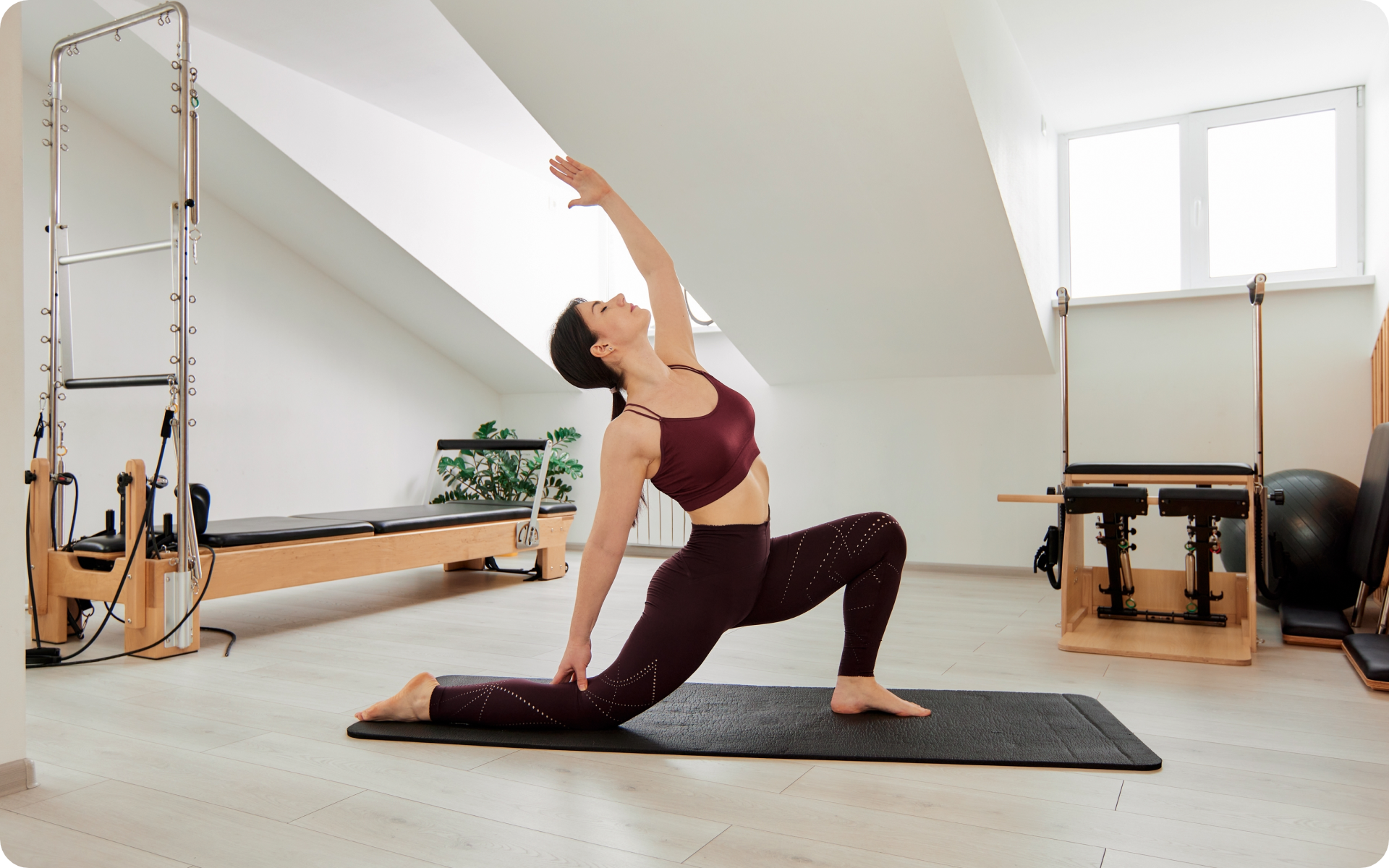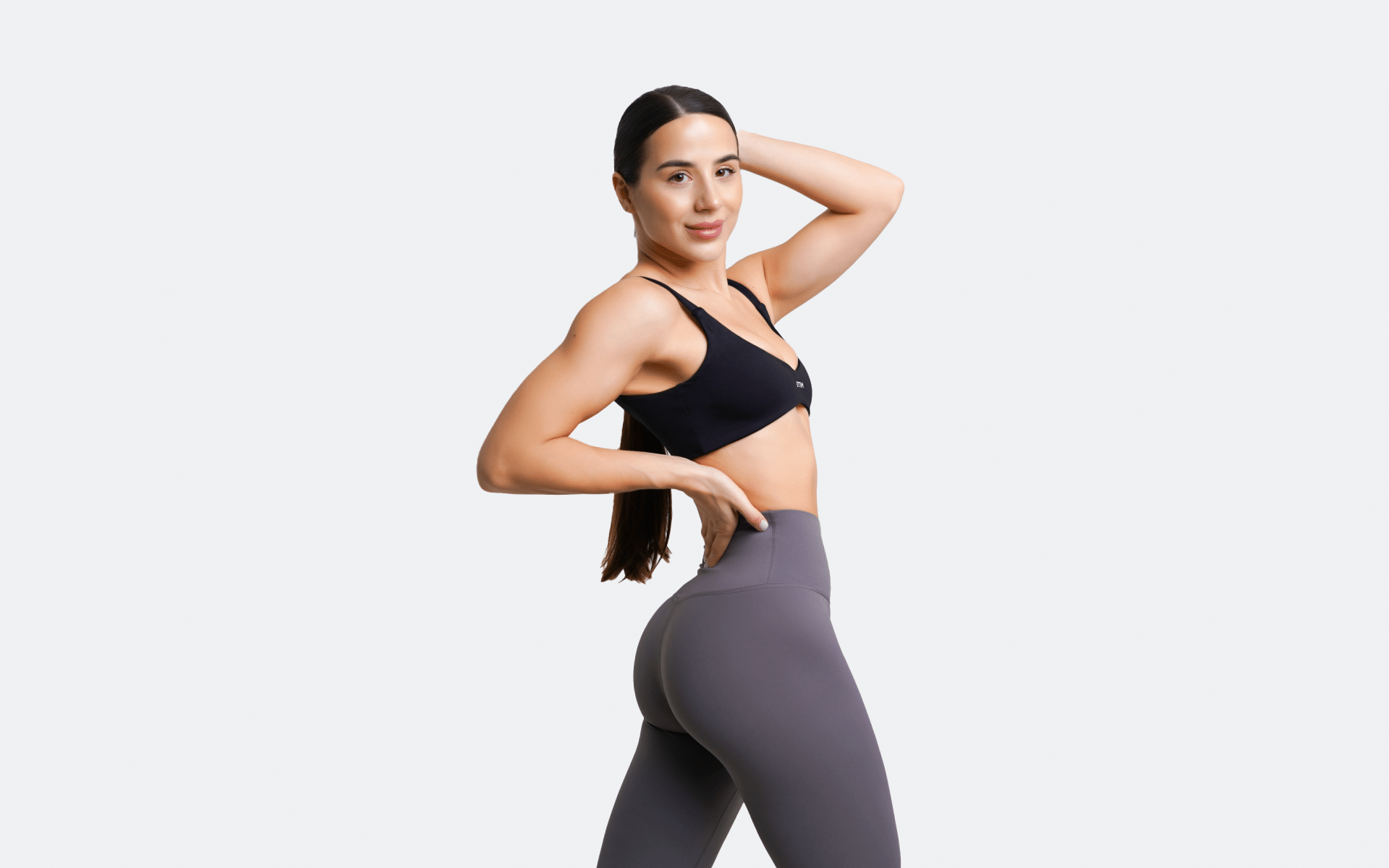When you first stand in front of a mini Pilates reformer, it’s normal to feel hesitation. It looks minimal, too simple almost. Most of us have a more traditional experience – typical Pilates studios, with their towering reformer machines and that ever-so-gentle spa music in the background. But this? This little thing looks like a cross between a bench press and a carry-on suitcase. And yet, in that tiny frame lives one of the most effective, whole-body workouts you’ll ever experience!
This isn’t another fitness trend that demands intensity and exhaustion, it’s a practice that is rooted in precision, breath, and control. The mini Pilates reformer workout is designed to gently wake up your body from the inside out. It encourages you to slow down, align your posture, and engage muscles you probably forgot existed, and it does this without the intimidation of bulky machines or fast-paced classes (1).
Unlike traditional reformer machines, the mini version is designed with portability and home use in mind. It’s ideal for small spaces, busy schedules, and for anyone who wants to reconnect with their body in a more mindful way. It offers many of the same benefits as a full-size reformer, but does so in a more accessible form.
But make no mistake: just because it’s smaller, doesn’t mean it’s easier. The resistance, the glide, the precision of each movement – it all adds up to a powerful mind-body experience – one where alignment meets breath, and effort meets grace.
In this guide, we’ll explore what makes this workout so transformative. From understanding how it works to crafting a mini Pilates reformer plan that actually fits into your life, we’re going deep. And yes, you’re gonna love it!
Pilates Mini Reformer
If you’ve ever seen a traditional Pilates reformer, you’ll know it’s not exactly something you can tuck under your bed after a quick session. With its rails, springs, and sliding carriage, it’s built for studios, not small apartments or multi-purpose living spaces. This is where the Pilates mini reformer steps in. It has the same thoughtful design, but it’s scaled down for convenience, and it brings the benefits of classical Pilates reformer workouts into your home without the bulk.
So, what exactly is a Pilates mini reformer?
A Pilates mini reformer is a streamlined, more compact version of the classical reformer machine. It’s designed to offer the same foundational benefits of resistance training, posture alignment, and core activation, but with a structure that fits right into your home, both physically and practically (2, 3).
While it still features a sliding carriage, resistance bands (in place of metal springs), foot straps, and shoulder blocks, the build is noticeably lighter. Most models are foldable, portable, and easy to store, which makes them ideally built for small spaces or those who like flexibility in their routine.
Reasons why BetterMe is a safe bet: a wide range of calorie-blasting workouts, finger-licking recipes, 24/7 support, challenges that’ll keep you on your best game, and that just scratches the surface! Start using our app and watch the magic happen.
What Makes the Mini Reformers Tick?
A Pilates mini reformer isn’t just a shrunken version of a studio machine. It reflects careful choices in design, resistance, and functionality, which makes it distinct. Below are the core mechanical and design elements:
- Carriage and rails: Like its larger counterpart, you move on a sliding carriage. However, with the mini version, the rails are shorter, so the glide is shorter, which means you must control your movements more precisely.
- Resistance system: Instead of heavy metal springs, many mini reformers use elastic cords, bands, or lighter springs. This offers adjustable resistance, while keeping the device lighter and more portable.
- Footbar, straps, handles: These still exist in miniature form – sometimes retractable or removable. They allow for footwork, leg work, arm work, etc.
- Support blocks and shoulder stops: These limit unwanted motion and provide cues for alignment.
- Frame and materials: High‑quality mini reformers use aluminum, reinforced plastics, or lightweight steel. Many are foldable or with collapsible parts to ease storage.
- Weight and portability: Some mini reformers weigh under 25 lbs (≈ 11–12 kg). Their compactness makes moving and storing them easier.
Due to these design features, the mini Pilates reformer offers a version of the classic reformer’s resistance and alignment benefits, albeit with scaled-down ranges and a bit more demand on your control.
Read more: BetterMe Equipment Pilates Overview: Reformers, Chairs, Kits, and Props
Physiological and Functional Effects
A well-designed mini reformer is more than a gimmick – it can deliver meaningful bodily benefits. Below are key physiological effects, supported by research and biomechanical principles:
- Resistance training with low impact
The mini reformer allows you to apply continuous resistance in multiple planes (push, pull, extend, retract), thereby challenging muscles without pounding joints. Traditional reformer Pilates is already known to be a low-impact, full-body method that builds strength, flexibility, and posture (4). - Core activation and stability
As the carriage can move, your body must resist unwanted shifts. This forces your deep core muscles (transverse abdominals, multifidus, pelvic floor) to remain active to stabilize (5). This is true in full reformer work and similarly in mini versions (perhaps even more, as the range is reduced, so finer control is required). - Balance, proprioception, and neuromuscular control
The sliding parts introduce a subtle instability. To maintain alignment, your nervous system must constantly recruit stabilizing muscles (6). This trains not just strength, but refined control.
- Improved flexibility and joint mobility
Many reformer studies show gains in flexibility, particularly in the hamstrings, hip flexors, spine, and shoulders (7). As the mini reformer still gives resistance while supporting motion, you can gently explore greater ranges without overstretching. - Postural alignment and muscular balance
The guided motion of the carriage helps you move with correct alignment, reducing compensations and asymmetries over time (1). - Benefits in body composition and metabolic health (indirect)
Although it has been less studied in mini reformers specifically, broader Pilates literature suggests that reformer-based Pilates can help improve body composition (reducing fat percentage) and maintain muscle mass, particularly in people who want to manage their weight or metabolic health (8, 9). - Mental focus and mind–body connection
The precision and control that are required demand attention. This can bring quiet, meditative awareness, making each session as much mental as physical (10).
Mini vs. Traditional Reformer – A Contrast
To put things in perspective, below is a strength-by-strength comparison between mini reformers and traditional reformers. Here’s what to expect:
| Feature / aspect | Traditional (full‑size) reformer | Mini Pilates reformer |
|---|---|---|
| Range of motion | Long rails allow deep glides, full extension | Shorter rails limit full extension; less “reach” |
| Resistance range | Strong metal springs with high resistance options | Elastic bands or lighter springs - more modest peak loads |
| Load capacity | Can support heavier users or more intense resistance | Often lower max resistance, may be limiting for advanced strength goals |
| Exercise variety | Broad repertoire - long strokes, advanced combos | Many core exercises are possible, but some advanced moves are constrained |
| Precision demand | Slight errors can be accommodated by larger levers | Mini setting magnifies technique errors - requires more control |
| Portability and space | Requires permanent studio setup | Compact, foldable, easier to move and store |
| Cost | Higher price, maintenance, servicing costs | More affordable, low maintenance |
| Accessibility | Best in supervised studio settings | Great for at-home, DIY use |
| Adaptation for beginners | Offers support, but may be intimidating | More approachable, less daunting - although still challenging |
| Long-term progression | High ceiling for resistance and complexity | Good for incremental growth, although may require creative progressions |
Key takeaway: You don’t “lose” all the benefits when you choose a mini version. Instead, you accept certain limits in range and load, but gain in terms of accessibility, space, cost, and consistency, which are all quite valuable for at-home training.
When Is the Mini Reformer a Better Fit?
There are multiple scenarios where the mini version isn’t just “good enough”, it may actually be the wiser choice. Here are cases where it shines:
- Space constraints: If you live in an apartment, dorm, or any shared space, setting up a full reformer is impractical.
- Time and consistency: As the mini reformer is easier to use and store, you’re more likely to slide into a consistent habit.
- Beginner learning curve: The smaller scale encourages you to master foundational control before moving on.
- Travel and portability: If you’re someone who travels often, the mini is far easier to transport or stash.
- Budget considerations: Its lower cost makes reformer-style training more accessible.
- Rehabilitation and joint sensitivity: The gentler resistance and guided support can make it safer for joint‑sensitive users.
Limitations and Caveats
No tool is perfect. Being aware of limitations ensures you use the mini reformer wisely:
- Limited maximal resistance
For advanced strength goals, the resistance caps may feel insufficient, particularly for strong users. - Reduced dynamic range
Some classic reformer exercises (long leg glides, deep stretches) may be attenuated or require modification. - Higher demand on control and technique
As there’s less physical buffer, errors are magnified. To avoid strain, your form really must be precise. - Durability and wear
As the design often uses lighter materials, durability may be less than studio-grade machines, while springs, bands, and sliding parts may need replacing sooner. - Limited instructor support
In a studio, you get hands-on cues and custom adjustments. At home, you must be more self-aware or use video guidance. - Ceiling on progression
Eventually, serious practitioners may outgrow the mini’s resistance or exercise library and need to transition.
Justifying the Mini – Why It Still Deserves Respect
Even given the limitations, here’s why choosing a mini reformer isn’t a compromise but a thoughtful adaptation:
- Better compliance: A tool used consistently, even at modest intensity, often yields better results than a less accessible, high-end machine that is used sporadically.
- Mind-body integration: As the load is gentler, you can emphasize precision, alignment, and breath, thereby unlocking deeper movement quality.
- Less intimidating: Many people avoid reformer work due to the machine size and gym environment. The mini version opens doors.
- Transition path: You can build a strong foundation of control and core engagement that is transferable if you use a full reformer later.
- Cost-to-benefit ratio: For many users, the gains in posture, mobility, strength, and stability justify the investment, due to how much simpler and affordable the mini option is.
- Supported by broader Pilates research: Studies on reformer Pilates (though not specifically mini versions) have shown benefits in strength, mobility, posture, and body composition (4).
Mini Pilates Reformer Workout
The mini Pilates reformer workout is different, not because it’s flashy or fast, but because it asks you to slow down and really pay attention to your body. It’s not about just “getting through” the reps, it’s about how you move and how that movement feels.
This isn’t your average home workout. There’s no rushing, no flailing around, and no trying to beat a clock. What you get instead is resistance that meets you where you’re at, whether you’re stretching, pulling, stabilizing, or pressing. And yes, your muscles will know they’ve worked.
What Makes This Workout so Effective?
Well, for starters, the mini Pilates reformer workout creates continuous resistance through every plane of the motion (11). Unlike bodyweight training where you’re typically just lifting or lowering in the sagittal plane, with the mini Pilates reformer workout, you’re pushing, pulling, extending, and resisting in all three planes of motion. And your core? It’s always on.
Every time the carriage slides beneath you, your body has to figure out: how do I stay stable? That single question keeps your deep stabilisers such as your transverse abdominals and pelvic floor, awake and alert (12), which, over time, makes your movements more precise. And your posture? Well, it tends to improve almost without you noticing.
Read more: Mat Pilates vs Reformer Pilates – Which One Should You Choose?
What Happens in a Typical Mini Pilates Reformer Workout?
Most sessions last around 25 to 45 minutes, although some days, 15 might be all you need. It’s not about doing more, it’s about doing what your body needs that day.
A simple structure might look like this (13, 14, 15, 16):
- Breath and Core Warm-up: Pelvic tilts, rib cage breathing, bridges
- Leg and Glute Work: Presses using the footbar, side-lying leg series
- Core Strength: Toe taps on the moving carriage, plank holds with resistance
- Upper-Body Focus: Strap pulls, bicep curls, rows
- Mobility and Flow: Supine twists, hamstring reach, spine stretch
Why It Works So Well
Because it demands your attention. You can’t “zone out” during a mini Pilates reformer workout and the unstable carriage won’t let you, and that’s a good thing! It makes each move feel intentional. You think about your spine, your breath, and your alignment. And that focus? It changes the entire experience.
And the best part: you don’t have to be a Pilates expert – even beginners can benefit. The resistance is adjustable, and the movement is controlled. So, there’s no jumping, no straining, no high-impact anything. However, you’ll somehow finish the session feeling lighter, taller, and more connected to yourself.
The mini Pilates reformer machine isn’t just about building stronger muscles, it’s also about building better movement – functional movement, the kind that supports you when you’re walking, climbing stairs, lifting groceries, or just trying to sit upright at your desk without that inevitable back pain.
Who It’s For (Hint: Probably You)
This kind of workout fits into so many lives. If you:
- Sit a lot for work and feel stiff more often than not
- Want to exercise without hurting your knees or back
- Struggle to stay consistent with long, hard workouts
- Are looking for a way to reconnect with your body, without the pressure to “go hard”
…then our mini Pilates reformer may be exactly what you need.
In addition, the flexibility to work out at home obviously makes it easier to stay on track. Whether you’re following a full-body routine or breaking it into short sessions, the at-home mini Pilates reformer helps you show up more consistently. And in fitness, consistency beats intensity almost every time.
Mini Pilates Reformer Plan
Creating a mini Pilates reformer plan isn’t just about stringing exercises together, it’s about understanding your rhythm and how your body’s mood is on any given day, as well as the progress you wish to feel, not just see. This is the real secret to making this practice something sustainable, not seasonal.
A great plan works like a rhythm: some days hit a powerful beat while others slow down to let you recover. What matters most is your consistency – showing up, even for 10 minutes, because every session builds upon the last. The BetterMe mini Pilates reformer approach embraces this balance beautifully.
How to Structure Your Weekly Routine
You can build your mini reformer plan around four key pillars: strength, flexibility, stability, and recovery.
Beginner Plan (3 days a week):
- Day 1 – Foundation: Focus on breathing, posture, gentle core activation
- Day 2 – Lower Body and Stability: Leg presses, side-lying glute work, supported bridges
- Day 3 – Mobility and Flow: Spinal twists, hamstring stretches, hip openers
Intermediate Plan (4-5 days a week):
- Day 1 – Core and Alignment: Controlled planks, pelvic lifts, toe taps
- Day 2 – Strength: Footbar presses, strap pulls, full-body flow
- Day 3 – Stretch and Balance: Roll-downs, side stretches, extension series
- Day 4 – Active Recovery: Breathing drills, light mobility, mindful flow
- Day 5 (Optional): Repeat your favorite session, focusing on form refinement
Duration and Intensity
Research has suggested that you must commit to 10 minutes a day. After building up stamina, control, and understanding, each session can last 20 minutes or more, depending on your energy (17). The goal is to engage your body. Move slowly, breathe fully, and listen for what feels right. You can increase resistance gradually using stronger bands or cords as your control improves.
Tips to Get the Most Out of Your Plan
- Consistency over intensity: Doing 15 minutes regularly will outshine a single long session every few weeks.
- Mind the breath: Every inhale creates space and every exhale builds strength.
- Precision over perfection: Better one slow, controlled rep than 10 rushed ones.
- Track your progress: Write down what feels easier, more fluid, or even what challenges you – awareness is part of the journey and helps you grow.
- Rest days matter: Pilates thrives on recovery – give your muscles time to integrate what they’ve learned.
Mini Pilates Reformer Exercises
Understanding the “why” behind each move will transform how you move. Below, you’ll find core mini Pilates reformer exercises that target major muscle groups while enhancing mobility and alignment. These can be rotated through your full-body Pilates reformer workout plan, or used individually for focused training.
- Footbar Leg Press
Targets: Hamstrings, quadriceps, glutes
Lie on your back with your feet on the footbar. As you press out, keep your spine long and neutral. Control the return instead of letting the carriage pull you back.
Why it works: Builds leg strength while training alignment from hip to ankle (18).
- Bridge Flow
Targets: Glutes, hamstrings, spinal extensors
Place your feet on the carriage and lift your hips into a bridge. Articulate your spine as you roll up and down.
Why it works: Strengthens the posterior chain and promotes segmental control – perfect for improving posture and back mobility (19).
- Arm Strap Pulls
Targets: Shoulders, upper back, triceps
Hold the straps and draw them toward your hips or chest while keeping your ribs grounded.
Why it works: Encourages upper-body tone and stability through controlled resistance – also improves posture (20).
- Toe Taps with Resistance
Targets: Core stabilizers, pelvic floor, lower abdominals
Lie supine with your feet in tabletop position, pressing lightly against the band or strap as you tap each foot toward the platform.
Why it works: Deep core engagement without straining the lower back.
- Side-Lying Leg Series
Targets: Glute medius, outer thighs, obliques
Lying sideways on the carriage, press the strap with your top leg in small, controlled movements.
Why it works: Builds lateral hip strength and balance; enhances stability for daily movement patterns (21).
- Seated Row or Bicep Curl
Targets: Arms, shoulders, mid-back
Sitting tall on the carriage, hold the straps and draw them toward you. Keep your chest lifted and shoulders relaxed.
Why it works: Develops upper-body strength while reinforcing postural alignment (21).
- Spinal Twist and Stretch
Targets: Obliques, spinal rotators, thoracic mobility
Sit cross-legged or kneel on the reformer, holding one strap. Gently rotate your torso while maintaining an elongated spine.
Why it works: Improves rotational flexibility and posture – great for releasing tension after long desk hours.
- Hamstring Reach
Targets: Hamstrings, calves, lower back
Using the straps around your feet, extend your legs toward the ceiling and slowly lower them, maintaining core engagement.
Why it works: Deep stretch for the posterior chain while strengthening the core stabilizers.
- Full-Body Flow (Integration Move)
Targets: Core, legs, shoulders – the whole body
Combine a plank hold with a knee pull and press, using the sliding carriage.
Why it works: Builds functional strength through integration, which teaches the body to move as one coordinated system.
You can weave these exercises into your mini Pilates reformer plan, alternating between strength and flow days. Or if you’re just starting, pick two or three moves, repeat them with focus and intention, and gradually expand your sequence as your strength improves.
Whether you practice in a studio or at home with a mini Pilates reformer, the key is awareness: movement that’s calm, coordinated, and conscious. The more you connect to each repetition, the more your reformer will become an instrument of balance, not just fitness.
Yes! Even 20 minutes of consistent Pilates daily can improve posture, strength, and body awareness over time. It means focusing 80% on precision and control, and 20% on effort – emphasizing mindful movement over intensity. It’s a simple structure: three strength sessions, two flexibility sessions, and one restorative flow each week for balance. Reformer Pilates can help create a toned appearance by strengthening the core and increasing your daily caloric burn. Pair this form of exercise with a healthy diet to create a calorie deficit so you can lose body fat and show off that strong core! Frequently Asked Questions
Is 20 minutes of Pilates a day enough?
What is the 80/20 rule in Pilates?
What is the 3-2-1 Pilates rule?
Can I lose belly fat with reformer Pilates?
The Bottom Line
The mini Pilates reformer workout isn’t just about exercise, it’s about returning to your body with awareness. Each glide, each controlled breath, asks you to move with intention rather than urgency. You don’t need loud music or heavy weights – you just need focus, space, and a little time.
Over the weeks, your movements will grow smoother, your balance will become steadier, and your posture will quietly transform – it’s subtle, yet undeniable. Whether you train in a studio or on your at-home mini Pilates reformer, what matters is showing up: consistently, patiently, and with curiosity. This workout isn’t a trend, it’s a reminder that gentle effort can create powerful change.
DISCLAIMER:
This article is intended for general informational purposes only and does not serve to address individual circumstances. It is not a substitute for professional advice or help and should not be relied on for making any kind of decision-making. Any action taken as a direct or indirect result of the information in this article is entirely at your own risk and is your sole responsibility.
BetterMe, its content staff, and its medical advisors accept no responsibility for inaccuracies, errors, misstatements, inconsistencies, or omissions and specifically disclaim any liability, loss or risk, personal, professional or otherwise, which may be incurred as a consequence, directly or indirectly, of the use and/or application of any content.
You should always seek the advice of your physician or other qualified health provider with any questions you may have regarding a medical condition or your specific situation. Never disregard professional medical advice or delay seeking it because of BetterMe content. If you suspect or think you may have a medical emergency, call your doctor.
SOURCES:
- Effects of Pilates Training on Muscle Strength, Posture, and Balance: A Systematic Review (2024, pmc.ncbi.nlm.nih.gov)
- Biomechanical Analysis of Pilates Reformer Exercises for Core Stability (2022, mdpi.com)
- Physiological and Functional Benefits of Pilates Reformer Exercises in Adults (2024, pmc.ncbi.nlm.nih.gov)
- The Effect of Pilates Training on Core Stability and Spinal Alignment (2013, pmc.ncbi.nlm.nih.gov)
- Transversus Abdominis and Obliquus Internus Activity During Pilates Exercises: Measurement With Ultrasound Scanning (2008, researchgate.net)
- Effects of Pilates on Core Muscle Strength and Lumbar Stability in Adults (2025, mdpi.com)
- Clinical Applications of Reformer-Based Pilates in Rehabilitation (2022, pmc.ncbi.nlm.nih.gov)
- The Effect of Pilates Exercise on Balance, Mobility, and Postural Control in Older Adults (2014, pmc.ncbi.nlm.nih.gov)
- Physiological Effects of Pilates Exercise on Muscle Endurance and Coordination (2018, pmc.ncbi.nlm.nih.gov)
- Comparative Study of Pilates Reformer and Mat Exercises on Core Activation and Balance (2024, pmc.ncbi.nlm.nih.gov)
- Muscle Activation and Stability Responses During Pilates Reformer Training: A Kinematic Study (2023, journals.sagepub.com)
- The Role of Pilates in Functional Rehabilitation: An Open-Access Perspective (2022, open.uct.ac.za)
- Joseph Pilates’ Original Exercise Principles: A Historical Perspective (1945, babel.hathitrust.org)
- Muscle Strategies for Leg Extensions on a Reformer Apparatus (2014, researchgate.net)
- The Effectiveness of Pilates on Core Strength and Muscle Control (2024, frontiersin.org)
- Neuromuscular Responses to Reformer-Based Pilates Training (2024, pmc.ncbi.nlm.nih.gov)
- Changes in Core Strength and Postural Stability After Pilates Training (2024, pmc.ncbi.nlm.nih.gov)
- Increased Strength of the Scapular Stabilizer and Lumbar Muscles After Twelve Weeks of Pilates Training Using the Reformer Machine: A Pilot Study (2016, researchgate.net)
- Scapular Muscle Activation at Different Shoulder Abduction Angles During Pilates Reformer Arm Work Exercise (2024, researchgate.net)
- Effects of Reformer Pilates Training on Postural Control and Trunk Endurance in Healthy Adults (2024, pmc.ncbi.nlm.nih.gov)
- The Effects of Pilates Reformer Training on Core Muscle Activation and Stability: A Randomized Controlled Trial (2024, pmc.ncbi.nlm.nih.gov)
